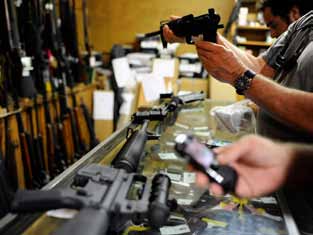[ Spring 2013 ]
In April 2009, over a five-day period, two young men and an older woman in New Hampshire each bought handguns from Riley’s Sport Shop in Hooksett and within hours committed suicide. The victims did not know each other. Soon, as often happens in a small, rural state, word spread, as did the desire to prevent such a triple tragedy from happening again. Thus began the Gun Shop Project, a novel collaboration, guided by the New Hampshire Firearm Safety Coalition, of mental health and public health practitioners, firearms dealers and gun rights advocates. HSPH injury researchers Catherine Barber and Mary Vriniotis helped organize the project, interview gun shop owners and develop educational materials.
To some, the notion of suicide prevention groups finding common cause with gun sellers seems implausible. But to Barber, it makes perfect public health sense. “You’re trying to reach gun owners,” she says. “Gun control isn’t the way to go for suicide prevention groups, because these groups are made up of both gun owners and non-gun-owners. Even internally, they might not agree.” In many ways, the gun-friendly state of New Hampshire–where the Association of Chiefs of Police recently raised money for an annual cadet training program by selling raffle tickets for 31 guns, including an assault rifle–is the perfect proving ground for creative approaches to gun-suicide prevention. Each year, the state sees about 20 homicides, but 150-200 suicides; about half of those suicides are by gun.
Riley’s sells thousands of guns each year. When he learned of the three suicides committed back-to-back with firearms from his store, owner Ralph Demicco was horrified. “The suicide issue deeply impacts me,” Demicco says. “I’ve had friends who have taken their lives. I’ve had wives of friends who have taken their lives. And as a businessperson, having a customer do it–it’s just an ugly, ugly thing. I decided I must become involved.”
Demicco reviewed the store’s surveillance tapes of the soon-fatal transactions, to see if the customers were giving away clues to their intent. They weren’t. But Demicco recalled earlier instances when he had picked up such clues: a customer asking for a very small amount of ammunition, or looking uneasy, or starting to cry after being asked a few questions–and his tactful inquiries diverted them from their plans.
Over the past three years, the Gun Shop Project group produced instructional videos and tipsheets for gun retailers. “Trust your instincts; you are under no obligation to sell a gun to anyone,” says a handout from the New Hampshire Firearm Safety Coalition. Demicco encourages all customers who are not familiar with firearms to get training before he will sell them a gun–valuable from a prevention point of view, because it buys time during which a crisis will often pass.
Posters and brochures for customers discuss how to make firearms inaccessible if a family member appears troubled. They also prominently display the phone number for the National Suicide Prevention Lifeline (1-800-273-TALK).
About half of New Hampshire’s gun retailers are participating in the project, and the Maryland Firearms Dealers Association will be adopting the model this year. The initiative even earned plaudits in the magazine Combat Handguns. The next step, says Barber, is to encourage suicide prevention groups to team up with other natural allies such as hunting groups, shooting clubs and gun rights groups.
“It’s important that gun owners and non-gun-owners talk to one another,” she says. “The question can’t be, ‘What do you think of gun control?’ because everybody’s going to be for or against. But when the question is, ‘How do we solve the problem of gun suicide?’ we can work out good ideas that everyone can agree on.”
Part 1: Guns & Suicide: The Hidden Toll
Part 2: Starting a Conversation
Survivor Profiles
“He was struggling with nightmares.”
“I couldn’t tell people that my father had died of suicide.”
“A club I never wanted to join.”
Download a PDF of The Gun Shop Project here
